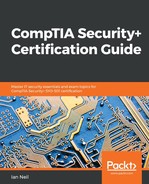ISO developed the Open Systems Interconnection model (OSI model). It is a conceptual model that standardizes the communication functions of a telecommunications or computing system, without regard to its internal structure and technology.
The purpose of the OSI reference model is to provide guidance to vendors and developers so that products they develop can communicate with one another.
The OSI reference model is a seven-layer model, and each layer provides specific services. The CompTIA Security + exam focuses mainly on layers 2, 3, and 7:
|
Layer |
Description |
Purpose |
Packet structure |
Devices |
|
7 |
Application |
The applications are windows sockets, such as HTTP for web browsers or SMTP for email. |
||
|
6 |
Presentation |
Formats data into a character format that can be understood. It can also encrypt data. |
||
|
5 |
Session |
Responsible for logging in and out. |
||
|
4 |
Transport |
TCP—connection orientated; UDP—connectionless |
Datagrams |
|
|
3 |
Network |
Responsible for Internet Protocol (IP) addressing and packet delivery |
Packets |
Layer 3 switch router |
|
2 |
Data link |
Works with Media Access Control (MAC) addresses. Checks for transmission errors from incoming data and regulates the flow of data |
Frames |
Switch VLAN IPSec ARP |
|
1 |
Physical |
Transmits data in raw format bits over a physical medium (cables) |
Bits |
Hub repeater |
Although Security+ is not a networking exam, you must ensure that you are familiar with devices that operate at layers 2, 3, and 7. These will be covered fully in Chapter 5, Understanding Network Components, of this book.
